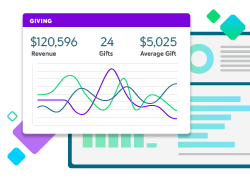Payment Processing for Nonprofits: Streamline Donations and Boost Revenue

Every dollar counts when it comes to fundraising. Your organization must have the tools to efficiently collect donations, manage transactions, and ensure the security of donor information. For nonprofits, processing payments without a hitch is essential in “normal” times, and it can be lifesaving in a crisis. If your social impact organization is still trying to cobble together a reliable payments solution with an expensive credit-card processing provider, an end-to-end payment platform could help you increase revenue and streamline donations so funds can be put to good use swiftly and efficiently.
Processing Payments in “Normal” Times
Even when we hit a stable patch—a “normal” time—your fundraising work is never done, and neither is the need for a system that improves everyday operations for your team. Your payment processing platform needs to be reliable, secure, efficient, and economical year-round.
Processing Payments in a Time of Crisis
In 2023, wildfires created the deadliest natural disaster in Hawaii’s history. In the midst of the complex Lahaina catastrophe, the Maui Strong Fund was able to respond quickly. Its payment platform processed donations from millions of generous supporters in 44 countries who flooded the foundation with critically needed gifts. The Maui Strong Fund, in fact, saw a 500% increase in donations immediately after the wildfires, an influx that required a robust, secure, and frictionless payment processing system.
Micah Kane, CEO and President of the Hawai’i Community Foundation which manages the Maui Strong Fund, said the right technology was critical to processing the extraordinary surge in gifts. The fund chose Blackbaud Raiser’s Edge NXT donation forms and processed gifts using Blackbaud Merchant Services. They securely processed nearly $175 million in donations in the first five months after the disaster.
“A mahalo to Blackbaud for providing the technology and support needed for our fundraising efforts for the Maui community,” Kane said.
The Maui Strong Fund maximized revenue by allowing supporters to cover their transaction fees and by accepting multiple payment methods. It made for a seamless experience for donors and a complete solution for the fund.
6 Considerations for Choosing a Nonprofit Payment Processor
Here are some questions to determine if your platform is making everyday operations easier for your team and helping you to maximize donations.
1. Do you have an all-in-one payments system?
A unified payment system that improves the overall online donation experience will integrate seamlessly with your entire tech stack—including fundraising, CRM, ticketing, and fund accounting software—allowing for easy processing of card transactions and simplified reporting.
With more than a million members supporting its work to protect natural environments in 70 countries and territories, The Nature Conservancy benefits from having a single merchant services provider across all their applications.
“It helps us reconcile,” said Cynthia Nair, membership systems project manager. “It helps us manage our credit card processing.”
The Nonprofit CRM Built for Fundraisers
Find out how Blackbaud’s Raiser’s Edge NXT® fits your organization.

2. Does your payments system increase donor giving?
A payment system purpose-built for nonprofits is designed to increase donor giving levels. For instance, best-in-class payment systems provide an option for recurring gifts, allowing donors to set up automatic giving. This feature drives increased revenue: According to the 2022 Blackbaud Luminate Online Benchmark Report, the annual value of a sustainer is four times greater than a one-time donor.
Consider, also, if your system supports high-volume online donations. Managing a deluge of gifts is vital in a crisis and for end-of-year giving, Day of Giving fundraisers, and capital campaigns.
3. Does your payments system offer real-time credit card updating?
Some providers only do updates once a month or once a week. Real-time updates produce a slight increase in your acceptance rate. Depending on the organization’s size, real-time updates can result in thousands (or tens of thousands) of dollars per year an organization can process. And that does not figure in the cost savings on follow-ups and phone calls. The Nature Conservancy relies on this feature to keep credit card data current, minimizing declined transactions and avoiding disruptions in regular giving.
“It helps us with our retention,” Nair said. “Rather than having to reach out to the donor to get a new credit card number when the bank might change (it), we have that updated monthly and can successfully charge the card.”
4. Is your payments system easy for donors?
Ensure donors have the most convenient ways to give by offering payment options such as Apple Pay, Venmo, and PayPal with a digital wallet solution. The Catholic Diocese of Trenton accepts all major credit cards, mobile wallets, and ACH.
“Making a donation via Venmo is an awesome experience,” said Christine Prete, associate director of development operations for the Diocese. “Making it easier for donors to give using the device and the payment method they prefer aligns so well with our vision for the ideal donor experience.”
An integrated system also makes for a great donor experience. The Akron Zoo uses a custom integration with their database so they can offer patrons digital membership options and self-serve kiosks.
“Whether you are at a kiosk, a register, or in the back office, all the data is in one place and in real time,” said Jeannette Andreski, guest services director. “This improves the guest experience because they never have to repeat information when they check in.”
5. Is your payments system cost-efficient?
Purpose-built payment processing systems help nonprofits save on every transaction. Your system should not have setup or hidden fees, and transaction fees should be transparent and easy to understand.
For the deepest cost savings, opt for a payment system that reduces processing fees by offering the option for supporters to pay a portion of the cost. Donor cover allows you to get the full amount of your supporter’s gifts without having to worry about processing fees eating into their donations.
Unique to the industry is Complete Cover from Blackbaud Merchant Services, which empowers donors to cover 100% of processing fees for their transactions, a model that has been applied to more than $1 billion in donations, rerouting thousands of dollars in processing fees back to mission.
“We have a motto in the advancement office at Manchester University: Do more with less,” said JoHanna Young, director of advancement services. “Running Complete Cover on our online donation forms helps us do just that. We saved $2,500 in just five months.”
6. Is your payment processing system safe?
To fight payment fraud and security threats, your payment processing system should be a Level 1 PCI compliant solution, with the basic ability to do card security code checks, address verification checks (AVS), and reCAPTCHA v3. In short, your system should be able to meet the industry’s toughest data security standards.
Your payment gateway should encrypt and tokenize your constituents’ credit card data, including vaulting card data for recurring donations or payments, removing your risk of storing this sensitive information.
A security breach can destroy the trust donors have in your organization, compromising your reputation and your financial stability. A secure payment processing platform with built-in and configurable fraud management tools can make sure payment transactions are secure.
Do these protections really work? Blackbaud Merchant Services blocked 2 million fraudulent transactions in 2022 alone, with a value of more than $324 million. Providing security with more of a personal touch, Blackbaud uses a combination of AI and humans who specialize in fighting fraud 24/7. AI catches what’s going on; experts then contact customers to provide needed support.
Conclusion
Payment processing systems purpose-built for the needs of nonprofits should make your organization feel empowered. The best payment processing platform will help you streamline donation collection, increase revenue, save on processing fee expenses, improve operational efficiency, and ensure you’re covered by top-tier security.
